Rock Climbing in Flagstaff, Arizona
Table of Contents
Update July 29, 2019: The July, 2019 Museum Fire has consumed many acres of National Forest land on the San Francisco Peaks, Mt. Elden, and the Dry Lake Hills. Until fire officials can asses damage, several crags will remain closed, including Solitude Canyon, The Peaks Crag, and Elysian Buttress, among many others. We at Hike The Planet! ask that you please respect the closures by not hiking or climbing within them. Thank you!
Arizona is rarely thought of as a climbing destination. It is often skipped over for climbing found in the neighboring states of California, Utah, and Colorado. In the minds of many, Arizona is seen as inhospitable desert, and little else. Yet, one look at a relief map of the state, and it becomes apparent that Arizona is full of canyons, mountains, ridges, and valleys that can harbor all manner of climbing potential. In the northern reaches of the state, the high elevations and shady pine forests of Flagstaff, Arizona offer respite from the heat, along with crags of all styles and rock.
For climbers new to this region, we have put together a brief guide to Rock Climbing in Flagstaff, Arizona. This guide will outline the type of climbing you can expect to find, and some of the most popular crags and climbing conditions. This article is not exhaustive, only highlighting the best climbing highlights that we here at Hike The Planet! feels that Flagstaff has to offer, but we hope that it will provide the info you need to get started climbing in Flagstaff.
Flagstaff, Arizona
Flagstaff, Arizona is a little Mountain town located right along the southern margins of the Colorado Plateau. It sits at a high elevation, with volcanoes poking up all around. Sandwiched between the Grand Canyon National Park, and the Red Rock attractions of Sedona, Flagstaff sees a steady stream of tourism traffic year round. As such, this quaint city has all the amenities (and vehicle traffic) of a big city, but with more access to the Outdoors. Hiking, Mountain Biking, Rock Climbing, and Snow Sports abound in Flagstaff (see: our article detailing the Top 10 Hiking Trails in Flagstaff, Arizona). Corollary to the nearby metropolis of Phoenix, Flagstaff is Arizona’s vacation town.
In the Summer, Phoenicians come to escape the heat, while tourists from around the world pass through the two major highways that make Flagstaff a southwest travel node. Come winter time, Flagstaff will find itself getting dumped on with snow. These snow accumulations, often several meters deep depending on the season, brings snow sport lovers to the Arizona Snowbowl, Arizona’s largest ski resort.
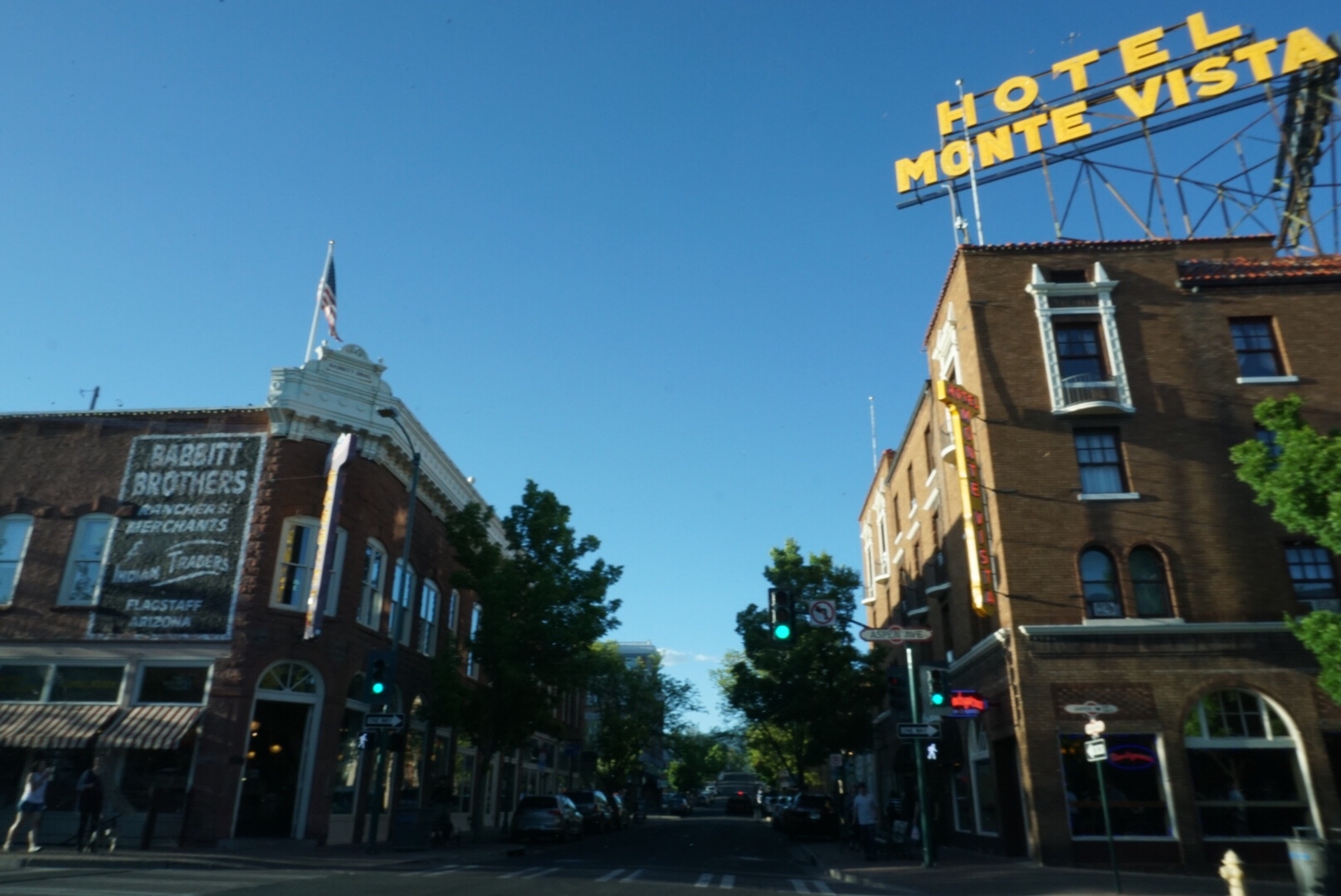
There seems to be a positive correlation between regions with ski resorts, and the amount of good climbing nearby. As it happens, Flagstaff’s topography lends itself easily to both. Flagstaff hosts all manner of climbing, on all manner of rock types. Sport Climbing, Trad Climbing, and Bouldering can all be found within a hop, skip and jump of downtown Flagstaff.
The unique and notable geology of Northern Arizona finds a home in Flagstaff, where it has mated with lava flows and cinder cones to create a perfect storm of climbing opportunity. Crags spring up in local Limestone and Sandstone, and perfect splitter cracks form in frozen lava flows as they drop off into deep canyons. Mountain Project lists hundreds of routes in the Flagstaff area, and more crags are being established as I type this.
Years can be spent climbing in Flag, and you still can’t scratch the surface. Just when you think you’ve climbed all there is worth to climb, more routes get established. If you drive a little further, nearly any style of climbing can be found on any rock type. There is Prescott’s “Big Wall”-Granite Mountain, and vertical adventures await the hearty in the Grand Canyon. Extend that drive a few hours longer, and you are in the mega destinations of Red Rocks, Joshua Tree, and Indian Creek. In the heart of the Southwest, the Flagstaff climber is in a prime spot to access some of the world’s best crags.
As it can be expected, Flagstaff touts a friendly, welcoming climbing community. With several outdoor gear shops, three gyms, and a local University that supports outdoor education, climbers will find Flagstaff to be a comfy spot. At the heart of this community is Flagstaff Climbing-a local gym, guide service, and gear shop that provides a community haven for knowledge, training, and route beta
Flagstaff Rock Climbing-A Few Considerations
Before you set out on a Flagstaff rock climbing adventure, a few things must be taken into consideration before roping up. These are some unique environmental and cultural factors that come into play, and by observing them, you can make your time climbing in Flagstaff happier, healthier, and more fun.
1. Elevation, Sun Exposure, and Dehydration
At 7000 feet in elevation, Flagstaff sits up on a Plateau high above the surrounding deserts. Significant elevation, especially for those not used to it, can put some interesting factors into play. First, the atmosphere is much thinner. There is less air to breathe, essentially making aerobic activity a little more challenging. This can be remedied with acclimatization, which is when your body adjusts to the altitude (admittedly, even after living here for a few years, we at Hike The Planet! are still not fully acclimated).
Second, the human body dehydrates much faster at altitude. For a few reasons, altitude causes your body to get rid of fluids even faster than at sea level. In order to stay healthy and hydrated, one must intake more fluids, more frequently. I carry a 48 oz. Nalgene, and need to refill it at least twice per day. Double that if I am exercising. Symptoms of mild dehydration can include irritability, reduced cognitive performance, and reduced physical performance. Severe dehydration can cause dizziness, vomiting, diarrhea, and death. Make sure that you have ample water close at hand.
Third, the high altitude equates to more intense solar radiation. At sea level, exposure to Ultraviolet Radiation from the sun has been linked to higher skin cancer rates. In Flagstaff, the UV rays are almost 30% more intense than compared to nearby Phoenix. Ultimately, this means that you can receive far more skin damage with the same amount of sun exposure. The increased intensity of the radiation is likely due to the presence of less atmosphere to absorb the incoming light waves. Be sure to wear plenty of sunscreen, and consider using other forms of sun protection, such as sun layers, or an umbrella.
2. Cultural and Historical Artifacts
Flagstaff sits in the middle of the largest outdoor museum in the world. In this corner of the country, Native American artifacts-some thousands of years old, are a common find. If you are out hiking, please do your best to respect any artifacts you stumble across by leaving them be, and admiring only with your eyes. After all, removing, vandalizing, or altering any historical, cultural, or archaeological artifacts is punishable by law.
Long before the arrival of Europeans in the Flagstaff area, it was home to a group of Puebloan Native Americans known as the Sinaguan culture. Here, they built cliff houses into the sides of canyons, settled atop volcanoes, and left many other signs of their occupancy, including broken pottery, and rock art. You can view much of these remains at local attractions such as Walnut Canyon National Monument, and Wupatki National Monument. These are some of the best places to visit such artifacts. If you stumble on anything while out hiking or climbing, please respect them.
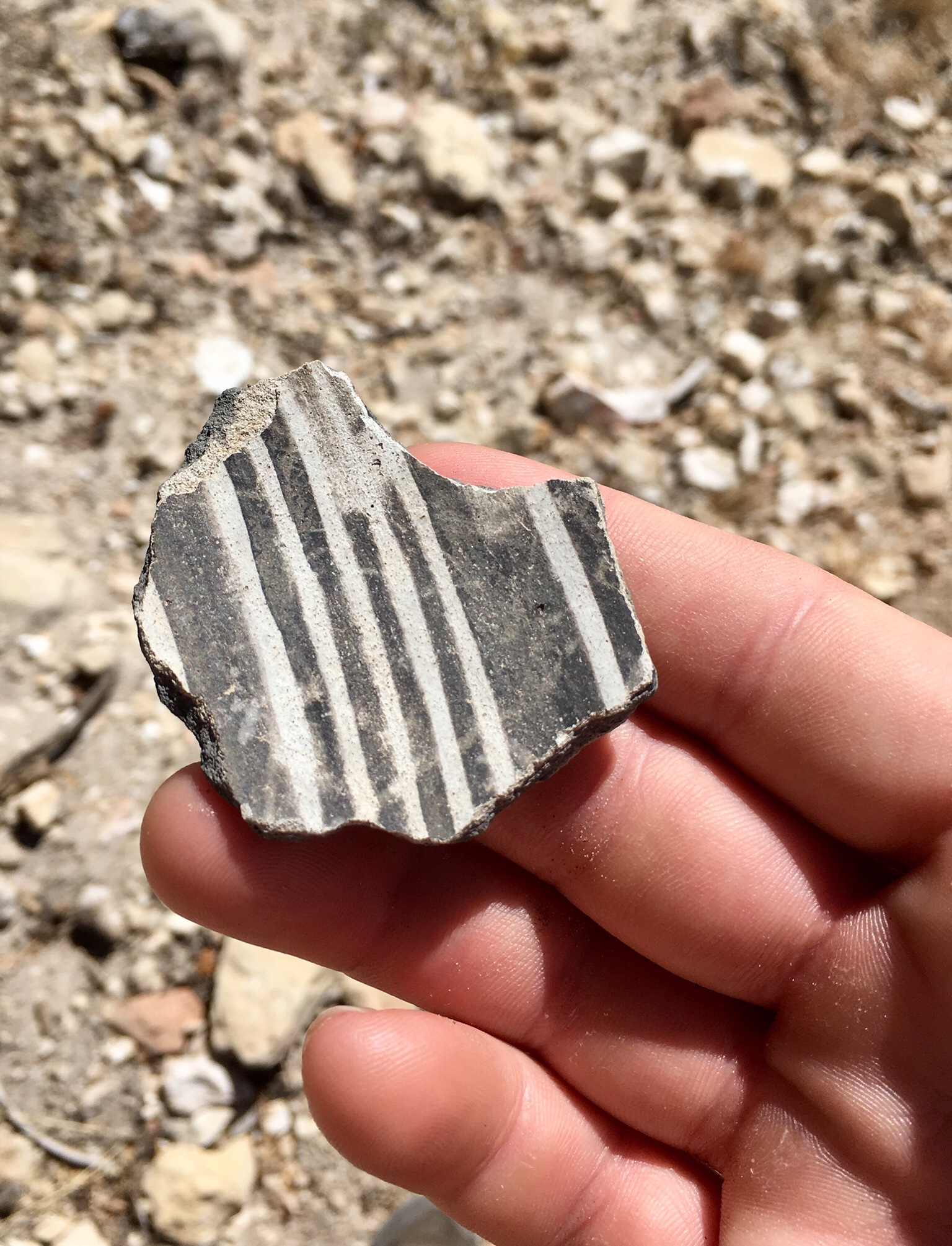
The Flagstaff Area is home to several landmarks considered sacred to modern day tribes throughout the Southwest, including the Navajo, Hopi, and Zuni. Many of these sites are still venerated by these groups. If you encounter a contemporary shrine while out and about, treat it as you would an ancient artifact.
3. Camping in Flagstaff
When visiting Northern Arizona, there are many camping options available. Camping is abundant, and many can be found within a short distance of nearly all crags. Free and dispersed camping can be done off any forest road, and the forest service has constructed many paid, established campgrounds. For more information on camping in Flagstaff, check out our article. In it, we detail some of the best spots for camping, as well as some pertinent rules, regulations, and tips.
Flagstaff Climbing Season
Flagstaff’s odd combo of high elevation and desert climate allows for a year round climbing season. Though winter snows regularly and liberally fall on Flagstaff, south facing crags thaw fast. Such cliffs include The Pit, and The Overlook, where temperatures can remain comfortable, even in the heart of Winter. Due to the high elevation, the mountain summers rarely rise above 90 degrees Fahrenheit, choosing instead to hover in the 70s and 80s. As such, finding respite from the heat can be easy in Flagstaff. However, the Southwest monsoons bring regular rain and thunder in the summers. These storms rarely last all day, making planning around these squalls a breeze (pun intended).
Flagstaff Sport Climbing
If clipping bolts is what your after, Flagstaff has plenty of quality sport climbing to keep you sending all year. Pockety, overhung limestone abounds at The Pit, where routes spanning the entire grade range can be found. The San Francisco Peaks and Mt. Elden harbor high elevation crags of volcanic stone. Here, the climbing becomes crimpy, slabby, and interesting. There is enough variety of sport climbing to satisfy any climber in Flagstaff.
The Pit
La Petit Verdon (a.k.a. The Pit) is Flagstaff’s (and Arizona’s) most popular and oldest Sport Climbing Crag. Easy parking, and a ten minute approach puts you at the base of this tiered limestone sport crag. The Pit sits in Walnut Canyon, thrusted by uplift from the adjacent Lake Mary Fault Zone. The result is a south facing, pocket laden sport destination with grades for every climber. The southern aspect ensures that sun hits this crag all year long, creating year round climbing conditions. Classics include the moderate, overhung Mr. Slate (5.10b) and The Joker– a relentless, crimpy test piece.

Mountain Project route descriptions are comprehensive, and constantly updated. This is a popular crag, and there always seems to be at least one party climbing here. For many Flagstaff Climbers, The Pit is treated as an outdoor gym. For a little more detail, a small guidebook to the area can be had at Flagstaff Climbing Center, and other local gear shops.
Hobo Jungle
Hobo Jungle is another popular Flagstaff Crag. The Jungle sits in a narrow, shady canyon on the north side of the San Francisco Peaks. Here, volcanic rock has created a variety of routes ranging from steep crimp-fests, to slab friction fun. This is a higher elevation crag, and can be inundated with snow late into Spring. Fortunately, Hobo Jungle can be a shady retreat from Summer heat. With views of the painted desert, a short approach, and plentiful camping nearby, this is a fun, accessible weekend crag.
Grades stand the spectrum, but the quality climbing doesn’t occur until the 5.11 range, with Mulligan’s Stew (5.11b) being one of the highest rated, most fun, and most climbed routes here. The grades are capped off with Steel Reserve (5.13c) being a featured hard man challenge.
Peaks Crag
Nestled within the southern folds of the San Francisco Peaks, Flagstaff climbers have long been climbing at a shady, idyllic cliff line known as The Peaks crag. Climbing here dates back years, but it has only recently become ‘open’ to the public when a decision was made to post this crag on Mountain Project. That’s good for this introverted, anti-social author, because he probably wouldn’t have gotten the skinny on this crag otherwise.
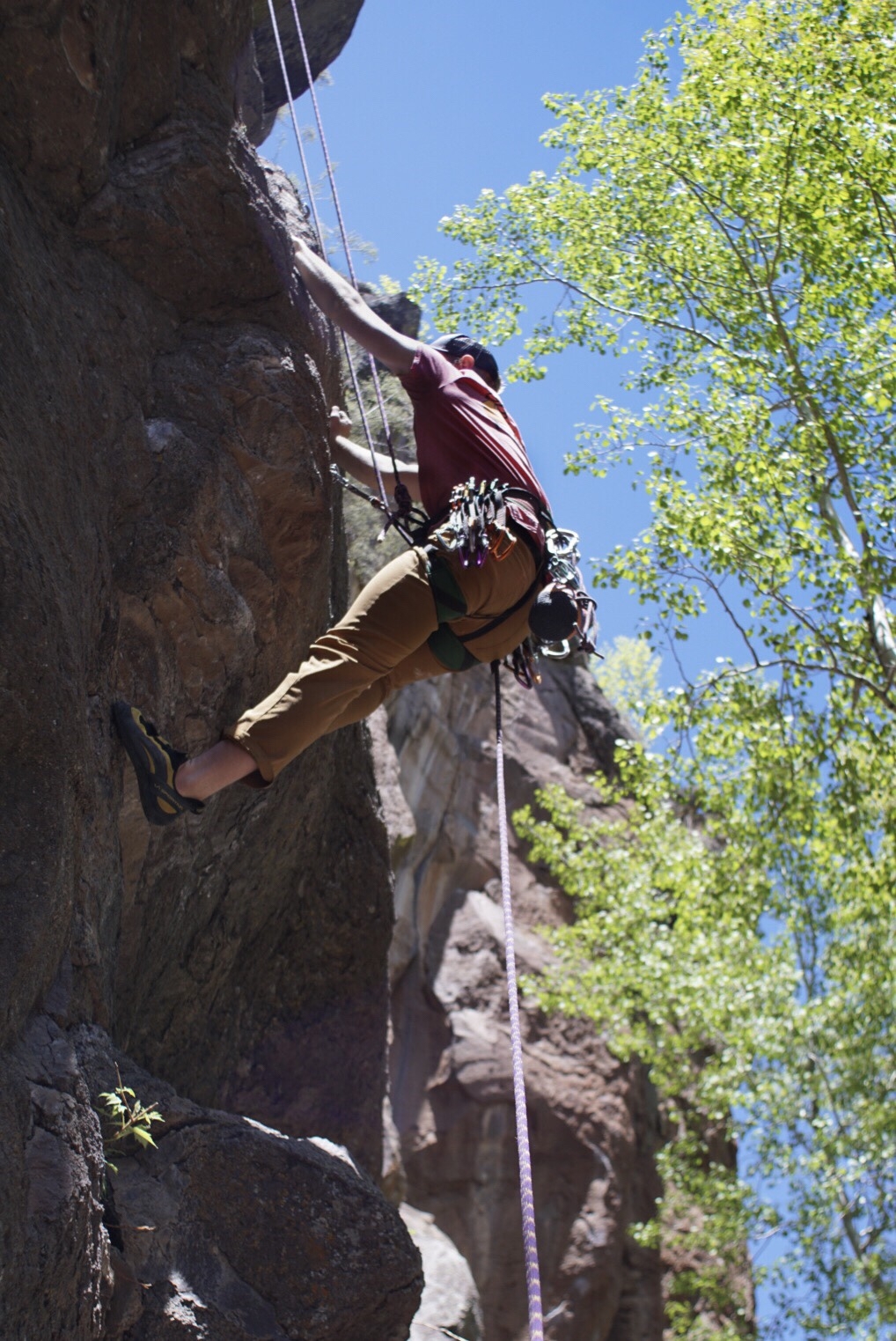
Another igneous face, this crag is no choss pile. Climbing here is downright pleasant, and the approach is long, yet gentle. Here you will find a mix of about 70 trad and sport lines, though the sport routes make up the majority. The quality climbing starts at 5.10, but there are routes for the climber of every skill level. Admittedly, I have only climbed at this crag once. This crag can be reached by parking off of Snow Bowl Road, and taking a divergent climber’s trail for half an hour through mixed pine forest, and Aspen groves. The Peaks Crag is entirely shrouded by Aspen Groves, making this crag a popular spot in the Fall climbing season.
Solitude Canyon
Mt. Elden’s Solitude Canyon is, in this author’s humble opinion, the best sport crag in Flagstaff. Beautiful, long lines on lava flows create fun, challenging routes. With rock very similar to that of Hobo Jungle, and The Peaks, Flagstaff climbers are well versed in this stone. From its soaring perch, this crag commands sweeping views of of Flagstaff’s west side. For the 5.11 and up climber, Solitude Canyon has the best climbing in the region.
What can be better? What is the trade off for such wonderful climbing? Well, Solitude Canyon can only be reached with the most heinous approach around. Starting at the sudden slopes of Mt. Elden, the hike to Solitude Canyon starts gentle enough, but quickly ramps up as you enter a steep, narrow drainage. The trail becomes more of a scramble, climbing through mixed pine, juniper, and desert flora. By the time you actually reach the base of the crag, you have hiked several miles, and gained at least 1500 feet. If the approach did not kick your butt too badly, you can now indulge your climber cravings on all the beautiful rock before you.
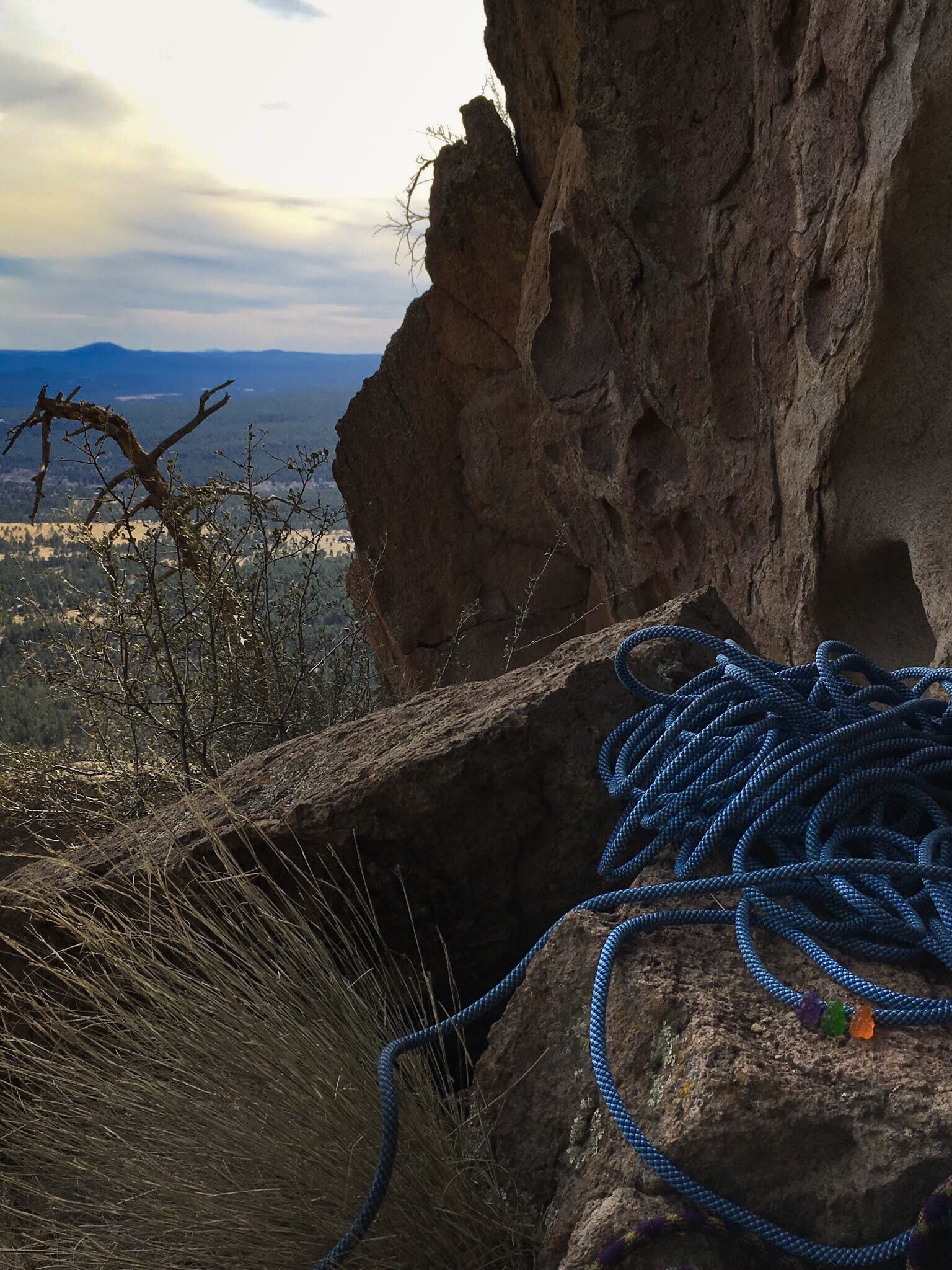
Like most volcanic dacite-andesite-whatever rock, the best climbs are found in the harder end of the grade spectrum. Solitaire (5.12) and The Hermit are two climbs for crushers (the term ‘Crusher’ in this context, is anyone who can climb harder than the author). The main attractant to this crag is a four pitch route known as Man on the Moon (5.10-). The first, stellar pitch features fun moves on vertical to overhanging rock, and the remaining three ease up considerably. Man on the Moon is a fun day outing, a great intro to multi-pitch climbing, and possibly one of the only bolted multi-pitch routes in Arizona. Solitude Canyon’s climbing season, despite its elevation, can last Fall through spring, where summer is generally too warm for climbing.
Flagstaff Trad and Crack Climbing
The original Flagstaff Climbing scene was born in a land full of decent to great trad cragging. In the early days, this tiny town was even tinier, and all the routes were climbed with hexes and pitons. Later, the innovations brought by the SLCD (spring loaded camming device) opened up even more opportunity. Though most modern climbers in Flag stick to bouldering and sport climbing, those who pursue cracks and gear routes will find a treasure trove of beautiful, inspiring climbing.
To find the best gear destinations, look to the lava flows. Where ancient lava flows have halted and cooled, clean, bullet hard splitter cracks will form. At the edge of canyons, these flows drop off, carved away by water and gravity. The result is an under appreciated, underrated, under the radar Shangri-La of a Trad Climber’s dream land. Paradise Forks, The Overlook, and West Elden are a few of such gems, where grades range from easy to test piece, pine groves shade patient belayers, and elk frolic. The Big Rock Candy Mountain for every dirtbag’s Subaru bumper sticker collection. Wiry finger cracks to wedgy off widths, there is something to fit every appendage.
Related: Yosemite Valley Top Ropes and Single Pitch Climbing
Overlook
Twenty minutes south of town sits The Overlook. Perched above the Oak Creek Canyon switchbacks, this is a tourist stop with a view. Frequently crowded by folks going to and from Sedona, squirrels here are fat from litter, and vendors peddle fake Native American Jewelry. The Rock Climber can circumvent the crowds by taking a short climbers trail to the edge of a cliff, and rapping into the upper Basalt layer that rims Oak Creek Canyon.
The Overlook features 80 foot basalt cliffs that demand a mixture of stemming, crack climbing, and sporty moves. The good climbing is often punctuated by generous rest ledges, and belayers are shaded by verdant forest cover. Many would argue about the quality of the climbing here, but one thing is for certain-the views are world class.
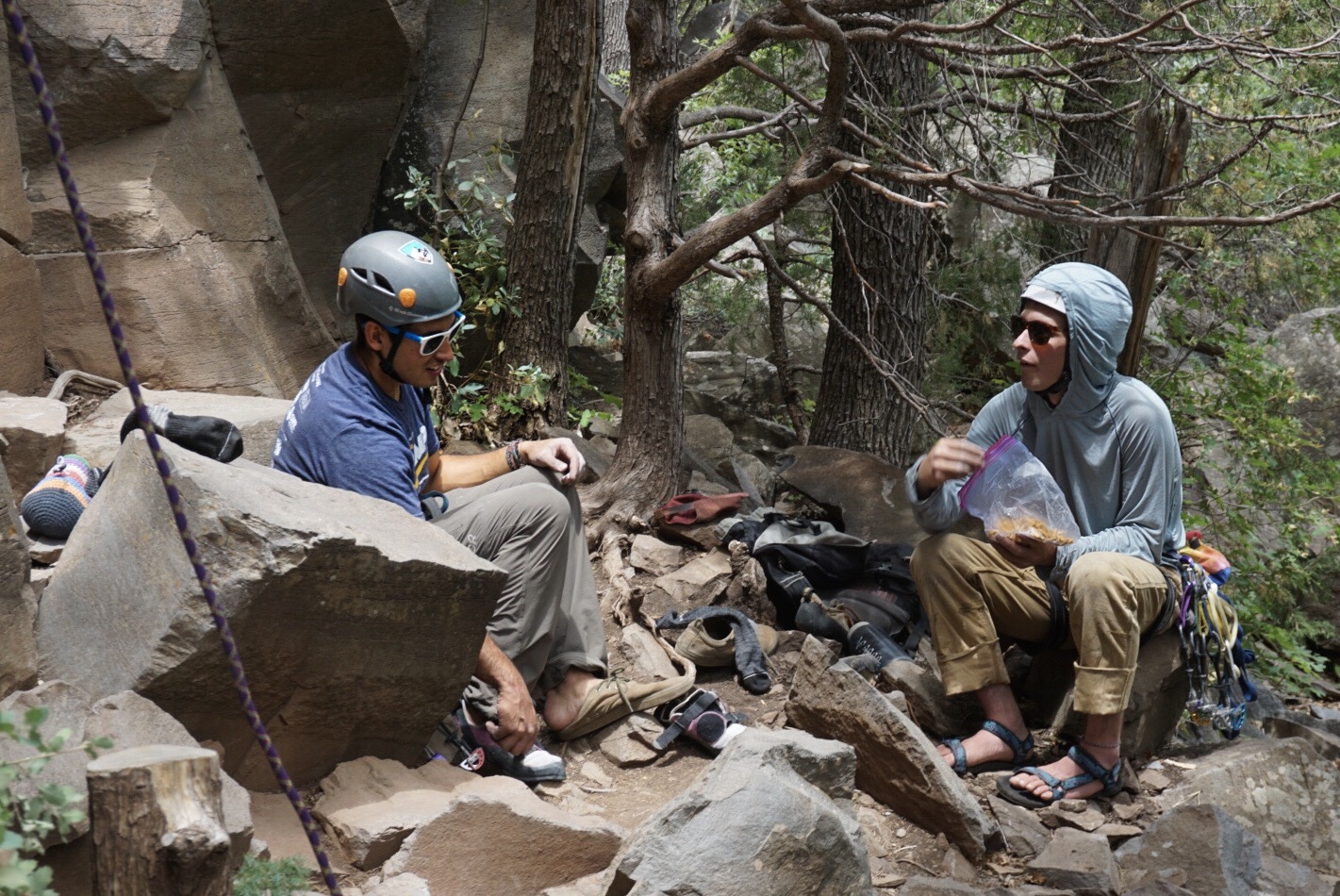
Climbing at The Overlook differentiates itself from nearby crags in a few noticeable ways. First, the routes here are a bit more technical, often demanding more creativity than pure crack jamming. There are more ledges, which both allow for more rests, but comes with increased decking potential. Finally, the rock is a tad chossier, but don’t let that last one dissuade you. Still, The Overlook features some fun classics, such as The Trinity Cracks and Isaiah. This area is a fine compliment to Sedona choss adventures, and is a decent destination, especially if you don’t want to make the drive out to Paradise Forks.
Paradise Forks and Sycamore Canyon
Paradise Forks (locally referred to simply as ‘The Forks’) is the author’s favorite Flagstaff Crag. This is a shady, remote basalt canyon that has hundreds of splitter routes on bullet hard basalt. Camping is allowed here, and the Forest Service was even kind enough to install a pit toilet. This collection of climbs is highly regarded in the Trad Climbing community, rivaling other crack Meccas in the Southwest.
The author cut his crack chops here. With the help of some big whippers, tape gloves, and ibuprofen, he finally taught himself how to jam. It will forever hold a soft spot in his heart, and he frequently visits it to this day.

Paradise Forks is a welcome crag to beginners. With a basic knowledge of anchor systems, anyone can rappel in and start sending. Unlike The Overlook, the rock here has less choss, and there are far fewer ledges. As a result, the falls are clean, and the gear is bomber. There are cracks of all shapes and sizes. Finger cracks, straight hand jams, off widths, and dihedral can all be found here. ‘The Forks’ is a great spot to become a better trad and crack climber. Traditionally, this area has a strong code of ethics. No fixed gear can be found anywhere in the canyon, and anchors must be built off of trees and rocks. When building anchors, minimize your impact by padding trees, and replacing any rocks that have been moved about.
Near The Forks is plenty of other Basalt Crack Climbing. Two other Crags-Volunteer Canyon and Whitetail Canyon, feature plenty of more routes, with some reaching upwards of 150 feet in length. The ethics here are not as staunchly observed as the Forks. You can find bolted routes, and fixed anchors here. It is said that development in the Sycamore Canyon area has barely scratched the surface, and that plenty more potential awaits the ambitious cracksters.
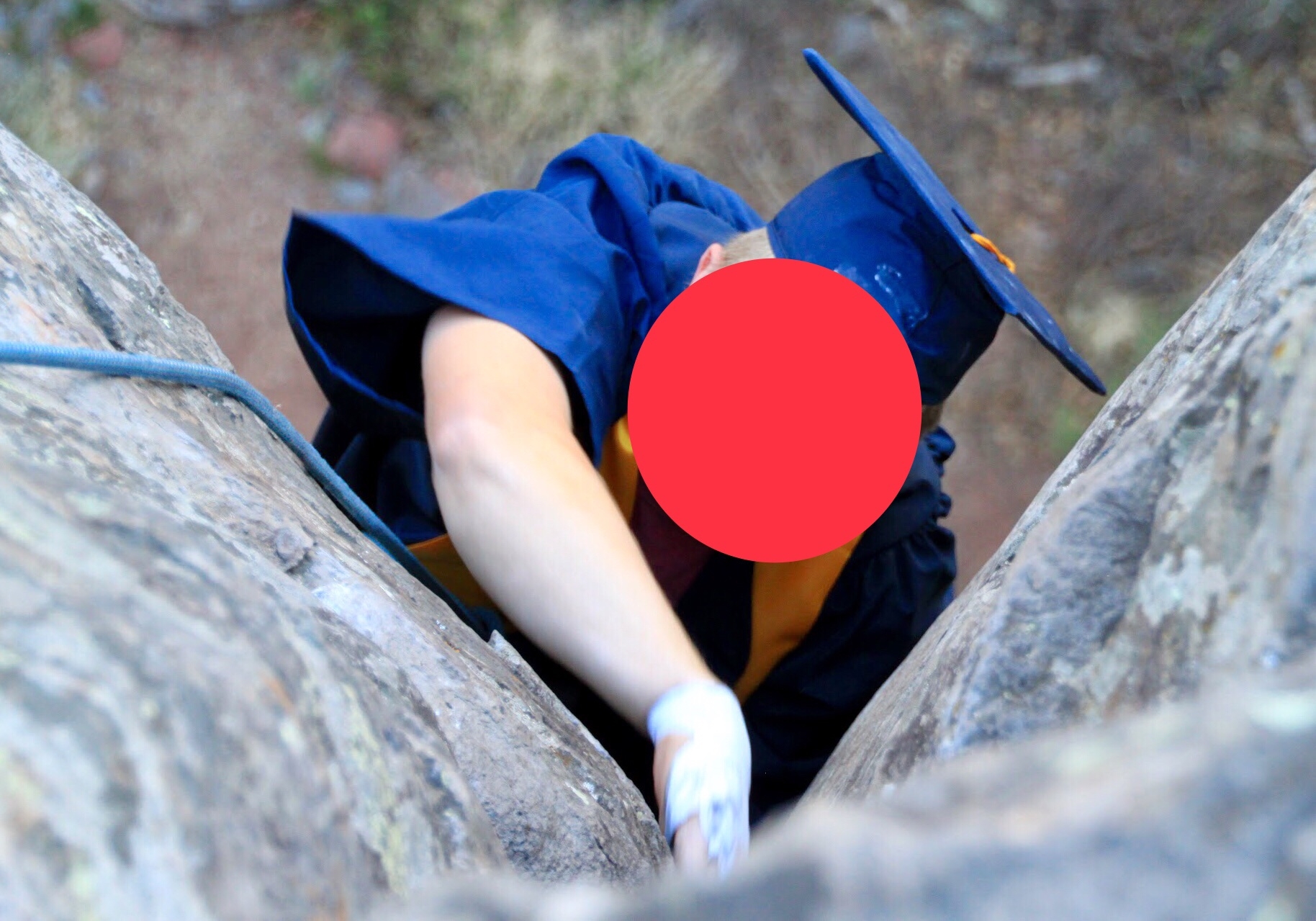
The Waterfall
Calling The Waterfall a Flagstaff crag may be a bit of a misnomer. It is located closer to Sedona, near the mouth of Oak Creek Canyon. Still, it has been developed, and largely visited by local Flagstaff Climbers.
The Waterfall is a relatively new crag. A similar genesis shared with the nearby Overlook, it is a wall of columnar basalt overlooking the canyon. To reach this crag, one must park alongside the heavily traveled Highway 89a, and hike up a loose, treacherous slope. The approach to this crag is no joke. Like Solitude Canyon, many are kept away by the nastiness of this approach. That, and the difficulty of the climbing.
Unlike the other basalt crags in Northern Arizona, The Waterfall is not at all friendly to beginners. One must be a strong Crack Climber, with a smattering of sport and bouldering moves in their repertoire. The warm ups here go at 5.10, and the routes quickly ramp up in the grades. This is a wall full of climbs waiting to test your strength.
This crag has often been referred to as one of the best single pitch trad crags in the country. It even features a 5.14 project, a coveted holy grail grade for only the hardest of trad climbers. It’s basically the equivalent of a 5.15 sport route, only constrained by the limitations of placing gear. The grades and the effort that has gone into developing The Waterfall further speaks to the quality of rock climbers that call Northern Arizona their home.
Flagstaff Bouldering
Are you a pebble wrestler, die hard through and through. Are you afraid of ropes? Did you start reading and feel disgusted at the lack of bouldering? Do you feel that I am prejudiced towards boulderers? (I am, but I’m working it out.) Well fear not, for the boulderer will find the greatest bounty in these lands.
Priest Draw
Of all the boulder fields scattered about, none are more gallant, more magnetic than Priest Draw. In every climber’s fantasy, there is room for a crag like priest draw. The author doesn’t even like bouldering all that much, yet still enjoys visiting ‘The Draw’ from time to time just for the atmosphere.
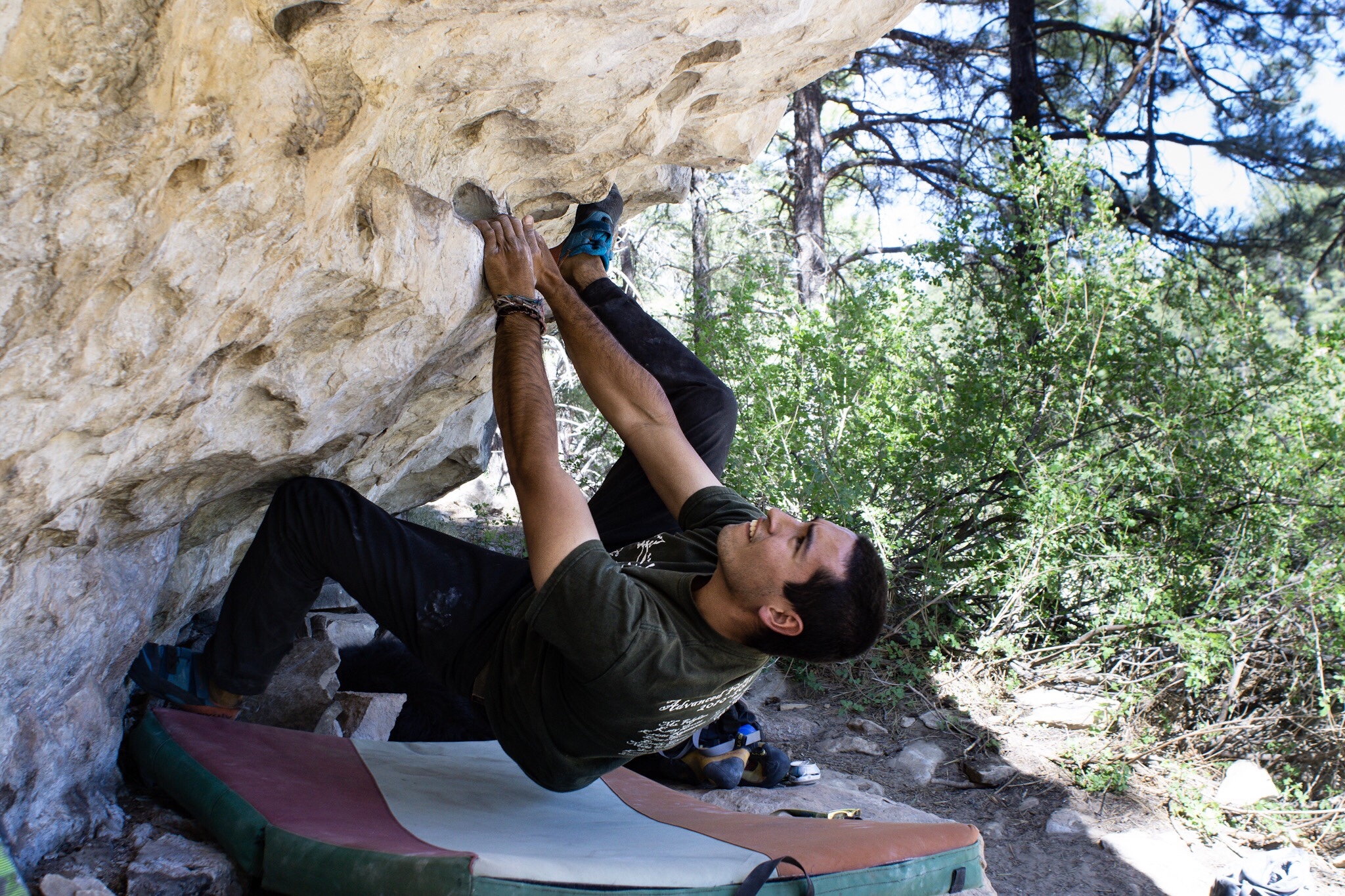
At Priest Draw, the rock here is all limestone roof bouldering. Think you’re strong? Send some time at the Draw and get shutdown on a v2 (that is usually my experience). Then lay around on crash pads, complaining about the grades, and getting no real climbing in. Still, if you like going upside down, jamming your toes into smeary pods, and hanging out under shady roofs, the The Draw might be the place for you.
Priest Draw has a high concentration of quality, classic problems, ranging in difficulty from V-Easy to V-Frustrating. A boulder can be found for every climber, and some devote all their time to unlocking the cruxy, tricky sequences demanded by the climbs here. Climbing at Priest Draw is so popular that the local climbing community comes together to host the yearly Flagstaff Roof Rally. Check out the mountain project page for more information, as I can’t possibly list all the best problems.
I don’t care much for bouldering, but I recognize the respect that Priest Draw deserves. If there is one climbing spot in Flagtown that is on climbing radars worldwide, it’s Priest Draw. It’s not uncommon to see European climbers roll up in Sprinters. Even Chris Sharma has made a stop here once or twice. Do yourself a favor, and check out this area. It’s beautiful, pleasant, and you may actually find some enjoyable bouldering.
Buffalo Park
Buffalo Park is a wide open city park sitting at the southern base of Mt. Elden. It is popular with joggers and dog walkers, and has really pleasant views of the mountains. This is one of my favorite running spots, and it is beautiful during the early evening golden hour. Buffalo park also sports a small but fun collection of boulder problems perfect for after work climbing.
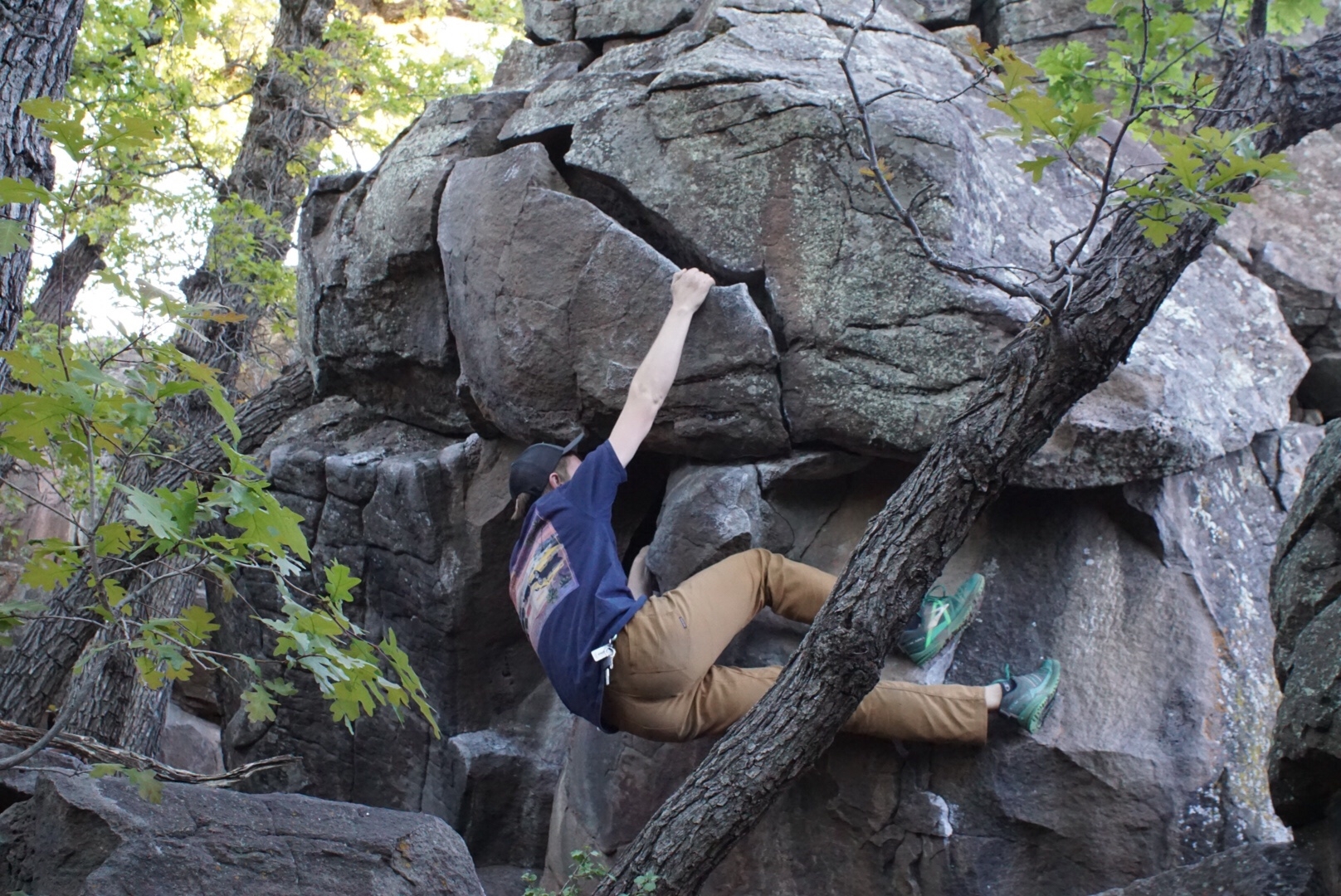
The boulders here sit along the edge of a lava flow, of which Buffalo Park sits atop. To reach these boulders, climbers must take a short approach around the park fence enclosure. There is not much climbing here, but it is concentrated and quality. The lava rock weathers into fun jugs, rails, crimps, and incut holds, with the occasional hand or finger crack thrown into the mix. Most of the climbs here can easily be protected with one or two crash pads, making solo climbing here easy and accessible.
Most of the climbs here are shaded by a canopy of Oak Trees. This spot would be very picturesque, if not for the constant noise of a nearby road. Still, this is a fun spot for a short sesh.
Glorias
Admittedly, the author has never climbed at this spot, but he hopes to soon. Gloria’s is a spot with plenty of local history and color. Many of Flagstaff’s pioneering climbers bouldered here. The rock is rough, technical, and volcanic. Like nearby Buffalo Park, Gloria’s is a fun spot with plenty of fun problems, and an easy approach.
The author is told that Gloria’s is a great spot to develop footwork and technique. The technical edging and careful stepping demands finesse. Maybe he will get out here when the forest finally reopens.
- The Best Campsites Around Big Bear California - February 26, 2021
- Hiking to the Hollywood Sign Via the Brush Canyon Trail - July 13, 2020
- Dirt Cheap Hiking and Backpacking Gear: The Most Affordable Gear on the Internet - July 4, 2020
